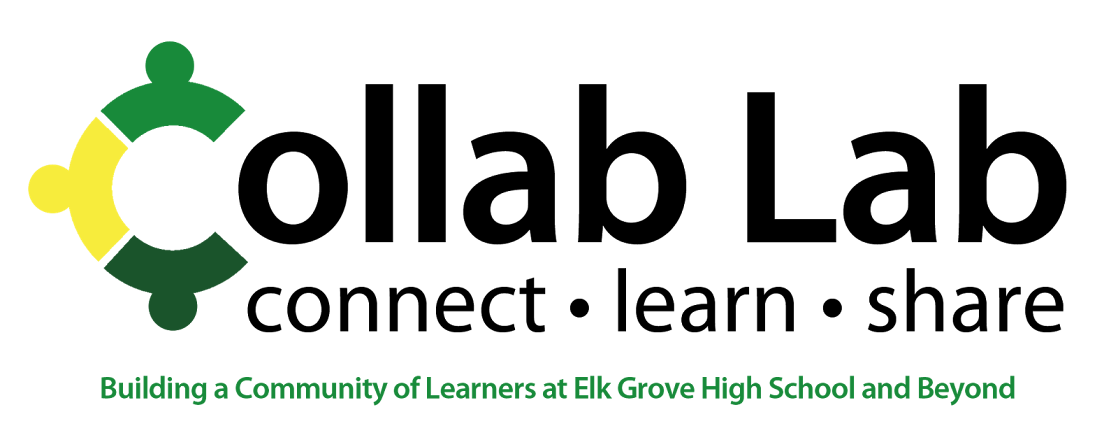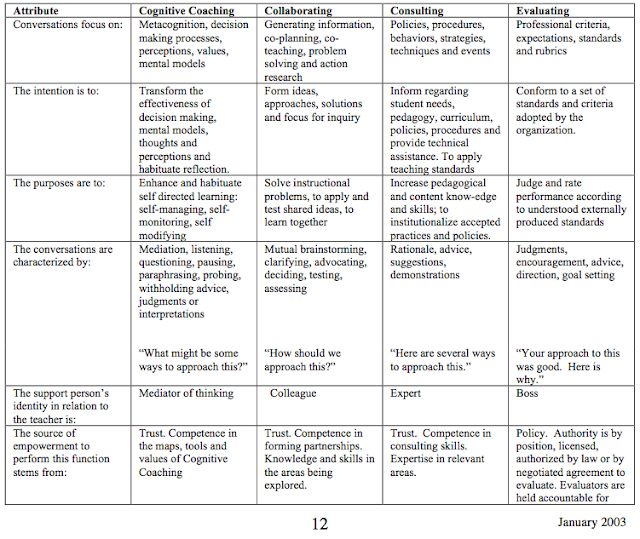Today the Collab Lab hosted a new variation on the Elk Grove High School tradition of peer observing, that started five years ago. (To learn more about the history of Peer Observation Groups at EG, check out this Google slide presentation.) On this Peer Observation Day we offered opportunities to visit classes every period of the day. Though the format has changed this year, the goal is the same: To provide ongoing, collaborative, and personalized professional learning opportunities to colleagues from across disciplines.
To inform staff about this professional learning opportunity, we messaged them the week before via Twitter and email using the infographic above. Without the need to RSVP, interested staff were invited to meet in the Collab Lab, during any period they had Conference or time free. Each period we went as a group to visit two different classrooms for about ten minutes.
Following the class visits, the groups returned to the Collab Lab to share applications, ideas, questions, and next steps related to our own work with students. We wrote notes on the Collab Lab white board wall to hold our thinking. It was great to see how the ideas grew as the day progressed. And even the notes themselves, not just the observations, sparked new ideas, as teachers could see what people had written from the periods before them. One of the DTCs who came in to the Collab Lab at the end of the day said, "Oh my gosh! There are so many great ideas on the wall since I left 5th period!"
An important point that came up in conversation each period was the need to remember that our focus is always on learning, and implementing technology according the student learning goals and our readiness for next steps. That is, just because we are a 1:1 school doesn't mean our lessons should be driven by technology. Some lessons we saw today would be considered "low-tech" and yet they were engaging, sometimes "hands-on," offering students time to think aloud, process learning with peers, make their learning visible and get immediate feedback. For example, in one lesson students collaborated and used string and paper labels to represent the great lakes and sustainability.
At the same time, we need to recognize and be open to learning about the ways that technology can, indeed, transform learning; learning experiences that couldn't be accomplished without technology. For example, today we say lessons that included: targeted and immediate feedback with Schoology Rubrics; collaboration, peer-feedback, and differentiated learning with Google Docs and BaiBoard; and, messaging authors via Social Media, in hopes of getting feedback directly from the source!
Another point that came up in our post-observation conversations was that with all the sparks of ideas we shared today, we should not put pressure on ourselves to do too much. It is important to strike balance, with an open mind to see and hear new ideas, and be inspired by them, and at then filter out the the next steps that make sense for each of us and our students. Furthermore, as several teachers mentioned, there is so much value in simply getting to know the work or our peers and our students -- what learning looks like -- in other classes. Even students throughout the day commented how interesting it was to see teachers learning together in their classes. Both staff and students were very open to having the peer observers wander around their classes and talk to the students about their work. We have so much to learn from the students too!
In addition to documenting our learning on the Collab Lab white board walls, the ITF / DTC team also created a shared Google Doc to take notes each period. The doc includes a chart with the names of teachers who have Conference each period (so we would could anticipate who might join us, and to follow-up to share our ideas). The chart also contains links to a note doc for each period which will also facilitate our future connections and next steps for learning.
Several teachers identified next steps they planned to take and they made arrangements to meet with DTCs in the Collab Lab. For example, one teacher plans to explore ways to engage students with Notability. He'll meet with a DTC tomorrow, try the ideas out in his classes, and then report back to us in the Collab Lab to let us know how it worked, and to share his example with others. This is just one example of the many ways that professional learning multiplies through our peer collaboration in the Collab Lab.
Today's observations inspired some good suggestions from teachers related to next steps for Collab Lab support of our professional learning. For example, one suggestion was to have themed Learning Labs, like "Notability Day" or "Baiboard Day," where any period of the day teachers could drop by the Collab Lab to explore ways to engage students, build collaboration, increase peer-feedback and student-ownership of learning, and give immediate and targeted feedback with one specific app. Staff could share examples with each other and have time to "play."
As one of our DTCs tweeted at the end of the day, it was a very informative --and FUN! -- day of learning together. To get more of an idea of what our day "looked like," check out tweets at #214Learns and #EG1to1. For some highlights of the days Tweets, check out this Storify.
We would like to give a big shout out to staff who welcomed colleagues to their classes:
1st Period: K. Fletcher - AP French, K. Miklusak - AP English Language
2nd Period: M. Heintz - Human Geography, K. Miklusak - AP English Language
3rd Period: Q. Loch - AP Environmental Science, B. Kale - Written & Oral Communication
4th Period: R. Barry - Honors Geometry, D. Saken - AP Psychology
5th Period: Q. Loch - AP Environmental Science, K. Fletcher - French 4
6th Period: M. Heintz - World History, T. Boczar - Physics
7th Period: M. Heintz - World History, C. Mullaney - Advanced Algebra
8th Period: B. Kale - Written & Oral Communication, C. Cirrincione - Human Geography
Also, a big thank you to all the staff who joined us on these class visits. We had from one to seven peer observers each period! We are looking forward to ongoing collaboration -- continued ways we will Connect - Learn - Share -- to strengthen our interdisciplinary professional learning networks even more, with our colleagues at Elk Grove High School, and in District 214 and beyond!









































